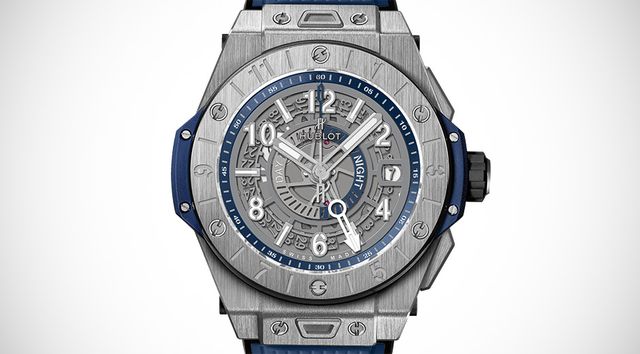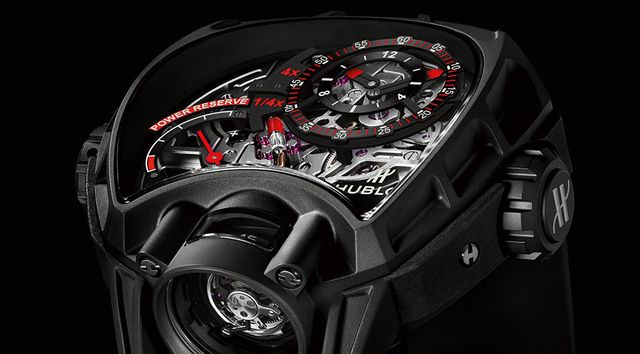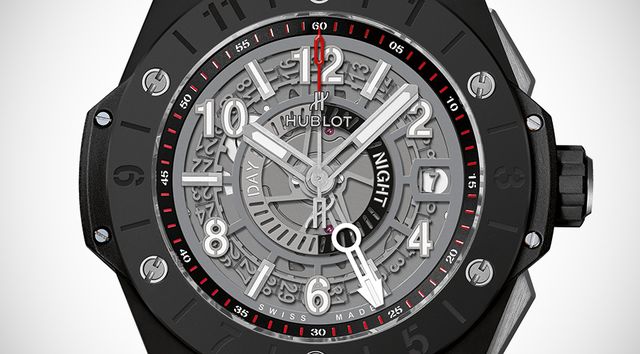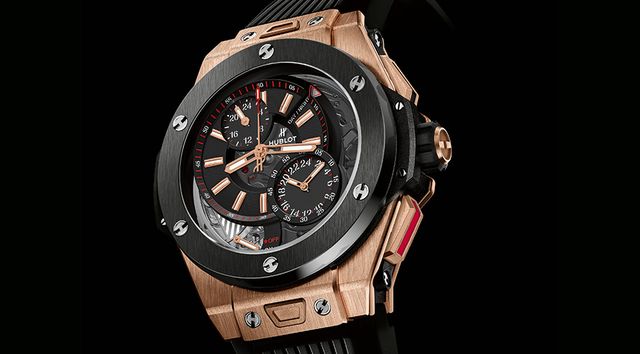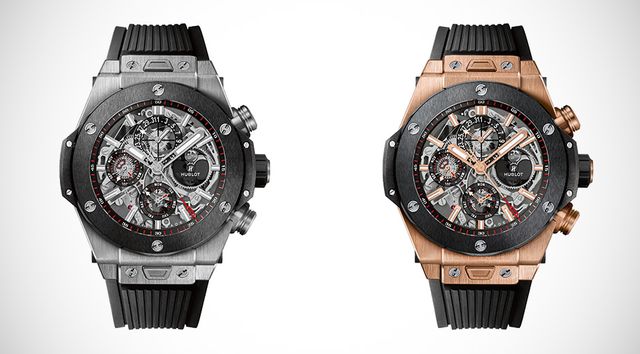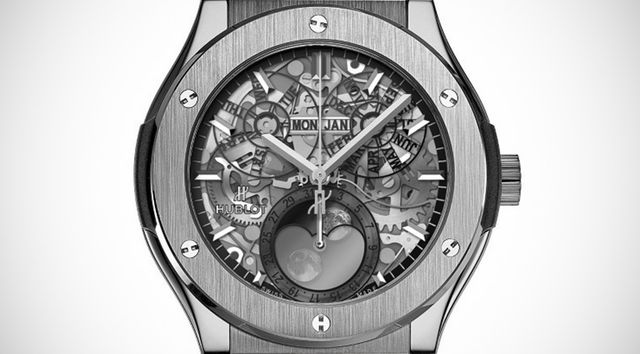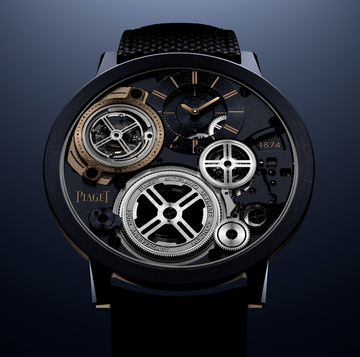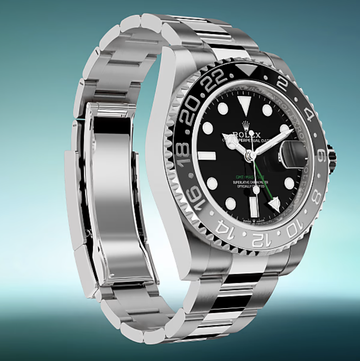It’s a sunny September morning in the town of Nyon, just outside Geneva. To a long, loud peal from three alpine horns, Jean-Claude Biver marches vigorously towards an assembled throng of journalists, photographers, industry dignitaries and friends of Hublot. He roars with delight as he spots Pelé, football’s greatest living legend, and the two men embrace like long-lost brothers. Cameras flash and the Hublot faithful – the brand, hilariously, calls them Hublotista – cheer. Then a white suited Lapo Elkann, dandy scion of the Agnelli dynasty and recent Hublot collaborator, appears from around a corner, pointing roguishly at Biver, who points back and roars again – more embracing, more cameras and cheering.
The alpine horns give it another blast, and the great man rushes over to greet rangy supermodel Bar Refaeli, who is stood betwixt a model cow on which guests have written messages, and a vast wheel of cheese (from Biver’s own herd). On an adjoining lawn a mini football goal is then unveiled, and Biver, Elkann and Pelé take turns firing penalties at a Big Bang-shaped target inside the goalmouth. Elkann smashes the ball right through it, to further cheers and waved iPhones.
“All you need is love!” Biver screams to the crowd, as the alpine horns let rip another volley. And with that, the second wing of Hublot’s watchmaking factory is declared open.
For Hublot skeptics, those who see it as a brand that’s all about the noise and not terribly much about the substance, such shenanigans will hardly convince otherwise. Ten years after Jean-Claude Biver wrought his Big Bang revolution, Hublot can still seem a parody of itself. For another example of "Hublot being Hublot", see the recent Big Bang Unico Sapphire, which we covered here. This watch embodies the duality of the brand; a lot of engineering heft is required, but the end result is something a lot will find hard to love.
But look deeper, scratch that embroidered carbon fibre surface, and there’s plenty that’s intriguing at a company that has transformed itself. It has one of the finest volume-produced chronographs in the world, the Unico – a movement that has gone from a few key pieces five years ago to being the backbone of a considerable manufacturing operation. Above the Unico, Hublot has to its name a slew of in-house calibers incorporating high complications in dynamic ways, along with its “masterpiece” super-watches that push horology in ingenious new directions.
In the field of materials and design, meanwhile, one may not always go for the look – and nor would Jean-Claude Biver expect that we do – but Hublot is doing as much as anyone to push at boundaries and have fun in the process. It embraces the weird, the kitsch and the unlikely with a Willy Wonka-ish enthusiasm, and just keeps rolling on. Thus the need to double the size of its factory just to keep pace.
Today Hublot makes around 40,000 watches a year, of which a quarter carry the Unico. According to the brand’s CEO Ricardo Guadalupe (Biver remains chairman, alongside his duties running TAG Heuer directly and overseeing LVMH’s overall watchmaking concerns), the expanded factory is less about increasing the main volume (though it will go up marginally in coming years) than increasing the percentage with a Unico movement, which will double to 20,000.
“There’s the possibility of another building and expanding further, but there’s a limit, because you have to maintain exclusivity,” Guadalupe says. “This is about the way we do things – the skills we have, the movements, showing that we’re able to produce our own major complications. We’re now an integrated manufacturer on the same level as other brands with a long, long history.”
That extends to cases too. Even among top-flight maisons, very few make their own cases, since it’s not remotely economical to do so. Such is Hublot’s interest in developing and incorporating far-out materials – most obviously with its scratch-resistant Magic Gold compound, but also carbon fibre derivations like the “Texalium” used in its collaboration with Elkann’s Italia Independent brand, and its wide use of ceramic – that it’s had to incubate the skills to do this internally. Around a quarter of Hublot’s cases are now being made in-house, and that figure is set to double too.
“There’s a lot of R&D we have to do ourselves,” says Guadalupe. “Innovation is the thing that’s crucial to us, and we’re working on so many new projects at all once, both on the movement side and the case side, and that takes a lot of investment and capacity.”
Firing on all cylinders
What’s really staggering with Hublot, whether you’re naturally a fan or not, is the rate and breadth of its creative output. A look at its website late last year revealed no fewer than 46 references listed under “novelties” – though that didn’t even account for all the watches unveiled in 2015. Raphael Nussbaumer, Hublot’s head of product development, admits it can all seem overwhelming.
“I don’t know where the limit is. Sometimes even our retailers say we have have too many models, but that’s Hublot – we go fast, and it works.” He describes an open creative process ultimately overseen by Guadalupe and Biver, into which any number of designers, suppliers and even customers will feed ideas. “It’s a really entrepreneurial approach; we don’t think about things over a lot of months – if we think something is innovative and suits the brand, we go, and we go very fast. Our reactivity is the key, it’s very different.”
Hublot is regularly accused (even by its own collectors) of milking its audience with the unending supply of limited edition colours and cases, so many of which are garish to the point of being gauche. But thanks to its growing industrial capacity, its creativity has ever-increasing horological bite. The past year alone has seen the appearance of an alarm repeater; a five-day power reserve tourbillon; a triple calendar moon phase; its first perpetual calendar; and a sensational skeleton tourbillon.
In fact, Hublot’s modernist attitude to skeletonisation has become an influential genre in its own right, another extreme example being the latest version of its bizarre Key of Time concept watch. Concocted within the horological R&D unit inherited from the embers of indie specialist BNB Concept, it allows you to adjust the “speed” at which time passes, without ever losing track of the actual time. The new MP-12 version, with its industrial aesthetic and complex ergonomics, is an oligarch’s dreamwatch that will genuinely tantalise tech-heads and design fans.
The latest arrival, announced this January, is more humble, but if you ask me a whole lot more interesting. In fact, it’s hard to believe the Big Bang Unico GMT didn’t already exist. Given the jet-setting aspirations of the Hublotistas (sorry), you’d expect travel watches to be a significant part of Hublot’s offering. However it’s four years since its last major GMT, the King Power GMT – a mess of rotating time zone discs that was unreadable and unloved.
Last year’s Alarm Repeater, a clever and restrained (by Big Bang standards) piece with a sonorous alarm function, did also have a GMT dial, though I’m not sure it needed it. However the new model demonstrates a clarity of concept that reflects the distance Hublot has traveled since the King Power monstrosity. A single GMT hand moves around a 12-hour scale etched in the bezel (most GMT watches have a 24-hour scale), overlapping a rotating day/night scale. Buttons in the normal chronograph pusher positions are for adjusting the GMT hand forwards and backwards.
As with Hublot’s debut perpetual calendar, unveiled last year, the GMT puts a module for the complication on the Unico base. Unlike the perpetual calendar, however, this complication is an in-house product, with a patent filed for the GMT system. Its open-worked dial follows the design code of other Unico-based watches, though unlike some – including the perpetual calendar – it’s relatively clear to read. That in itself is a step forwards.
According to Hublot’s management, there are no plans to develop an ETA-style time-only tractor movement for the brand; the perpetual calendar and the new GMT – along with the retrograde-display football timekeepers – demonstrate the Unico’s built-in adaptability as a base for complications. With the investment in capacity, and given Hublot’s unfettered approach, the possibilities are more or less endless.
But interesting things have been happening away from the Unico also. Early last year came the Aerofusion Moonphase, Hublot’s first watch with a lunar display, but more importantly a full calendar watch in (relatively) traditional style, with a completely new integrated movement.
The Alarm Repeater is a different and rather original entity, however. The brand more or less announced its arrival in the field of top complications with its Cathedral Minute Repeater Tourbillon back in 2011, which demonstrated the unlikely but stunning acoustic qualities of a carbon fiber case – originally in the huge King Power case with a chronograph attached, this watch was reborn last year, sans chronograph, in the more conservative Classic Fusion style, and all the better for it.
The Alarm Repeater offers something different, however – a sonorous, haute horlogerie take on the alarm watch, and a chiming complication at a significantly lower price. The movement was in this case developed in partnership with the complications specialist Chronode – as Guadelupe points out, it’s precisely this kind of project, and the research behind it, that the expanding capacity will bring in-house in the future.




